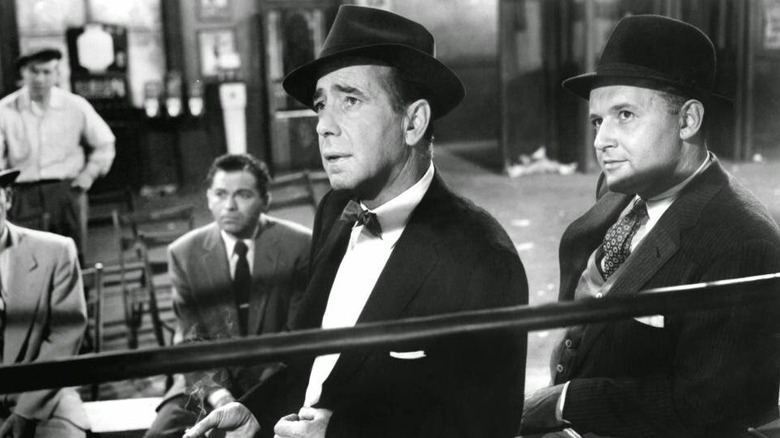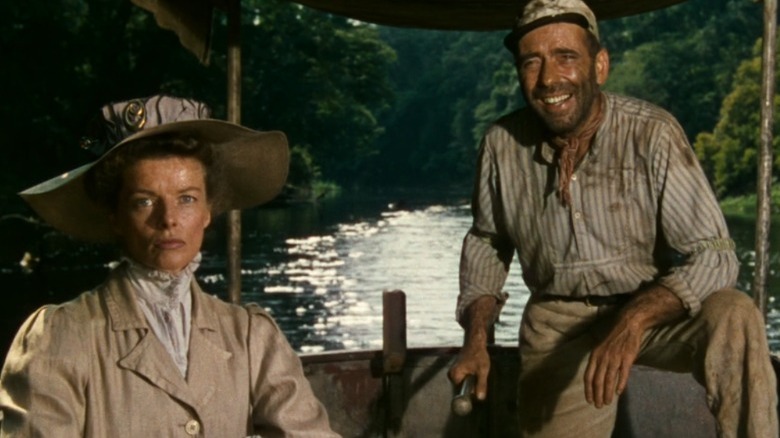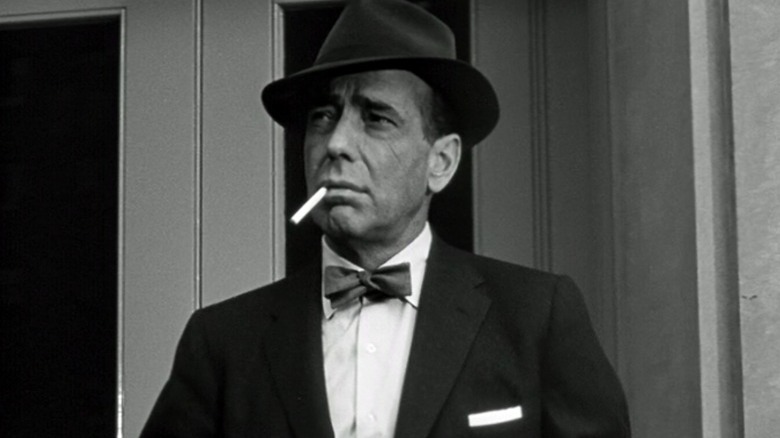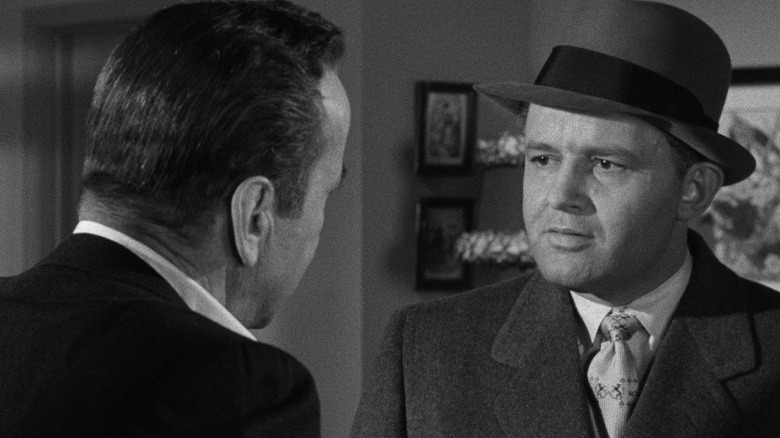The Harder They Fall's Cast Made It An Awkward Prospect For Humphrey Bogart
By the time of Humphrey Bogart's final film performance, in 1956's "The Harder They Fall," the movie star had fallen gravely ill. His years of smoking and drinking climaxed with what would become fatal esophageal cancer, which cast an unmissable pall on his performance. And yet, he still brings his star-making qualities: the toughness and bitterness, the anger and wry sarcasm.
Because "The Harder They Fall" is just one of many noir-era movies about the boxing underworld, it gets less respect than Bogart's many classics. He hadn't even wanted to be in the movie, focusing his remaining energy in vain on another movie with his wife Lauren Bacall, according to Stefan Kanfer's Bogart biography "Tough Without a Gun." He had many reasons for not being interested in the movie, but the cast was a big one.
"The Harder They Fall" is unromantic and cynical, with Bogart, reduced by his sickness and surrounded by heavies, playing antihero for most of its runtime. Eddie Willis (Bogart) is a former sports journalist, hired by promoter Nick Benko (Rod Steiger) to be his publicist. Eddie lends legitimacy to Benko's scams, in this case the rise of a gigantic Argentinian "boxer" (Mike Lane) who can barely throw a punch.
Bogart was preparing for a fight of his own with the cast of the movie, particularly Steiger, who would be his major scene partner. The problem was generational. How could Bogart, who had moved from Broadway to Golden Age Hollywood, relate to the new school of Actors' Studio members, whom — according to Kanfer — Bogart referred to as "scratch your ass and mumble" actors?
The new school and Bogart
Conceived in the 1940s by future film director Elia Kazan and Broadway producer Cheryl Crawford, the Actors' Studio brought acting techniques from turn-of-the-century Europe to America. It allowed American actors to learn the teachings of Moscow Art Theatre's Konstantin Stanislavski.
In America, that became what we now call Method acting (which devolved into the kind of Method acting derided here by Jon Bernthal). The "Method," based on tasks, circumstances, and actions, demanded concentration from its adherents, and they were rewarded with visceral performances. It's no wonder the school made instant movie stars of its members, like Rod Stieger and Marlon Brando.
Meanwhile, Humphrey Bogart had needed some time in Hollywood before finding any appreciation. His lisp and sneering demeanor had led to his being typecast as a gangster, and his Warner Bros. supporting work kept the spotlight squarely off him. Even after a decade-plus of heroic roles, it wasn't until 1952 that he won a Best Actor Oscar, playing the uncouth charmer Charlie Allnut in the warm-hearted but decidedly old-fashioned Katharine Hepburn romantic comedy, "The African Queen."
His main competition that year was Brando, who lit up the screen as Stanley Kowalski in Kazan's "A Streetcar Named Desire," demonstrating the power of Method acting in giving audiences a sympathetic brute. Bogart might have won that particular contest, but he was losing the war to the "scratch your ass and mumble" gang. And then he had to make a movie with them.
Legends meet
As Stefan Kanfer's biography "Tough Without a Gun" put it, Humphrey Bogart was a "hard-to-cast leading man" by the mid-'50s, with a thinning hairline and teeth falling out. His Oscar-nominated performance in 1954's "The Caine Mutiny" was just a nomination, and for some of his most compelling work. The winner that year was Marlon Brando, for Elia Kazan's morally complex "On the Waterfront."
Bogart didn't hide his resentment for the new school. He's quoted in the A.M. Sperber and Eric Lax biography as saying, "I came out here with one suit and everybody thought I was a bum; when Brando came out with one sweatshirt, the town drooled over him." Bogart took issue with the way these actors affected naturalism. Not just Brando, but his "Waterfront" costar Rod Steiger (who had his own troubled relationship with Brando).
While he was contract-bound to make "The Harder They Fall," Bogart was put off by the cast (which included Steiger and another Actors' Studio disciple, Nehemiah Persoff; the only actors to ever work with both Brando and Bogart) as well as the writer: Budd Schulberg, whose screenplay for "On the Waterfront" had won an Oscar.
The only thing Bogart could do was keep it professional. While Kanfer claims he had many sleepless nights over sharing the screen with those actors, you could never sense it watching him hold his own. Indeed, the movie's seedy milieu proved a better fit than most of his '50s movies. Stieger came to respect him.
Stieger had respect
Rod Stieger would go on to praise Humphrey Bogart for his professionalism. If the older actor had little patience for the Method technique, he didn't show it on set. When Steiger realized the extent of Bogart's illness, he also realized how much the actor cared about completing the movie. As he recounted in David Fantle and Tom Johnson's interview book "Reel to Real," he saw Bogart once staying late on set to re-do some closeups on account of his watery eyes — he realized later that Bogart's eyes were watery out of pain.
As Stefan Kanfer puts it, "the younger man got a particular kick out of watching the old one when he got going." By movie's end, we see Bogart's Eddie Willis powerfully rebuke Stieger's Benko, with a performance that has all the visceral thrills audiences had come to expect and cherish.
The nature of the Actors Studio was at odds with Humphrey Bogart's approach to acting, at least on the surface. Bogart may have suggested no pretensions about the craft of acting, fiddling with a cigarette as a performance aid or sometimes showing up on set hungover, according to the biography by A.M. Sperber and Eric Lax.
But Bogart's acting and its appeal shows that he may have understood the Method on some level. Rewatching his best work always reveals him to be a powerfully naturalistic actor even in the context of pulpy melodramas, who found ways to express character that went beyond anything in the script. It's hard not to imagine the Actors' Studio members taking that to heart.



